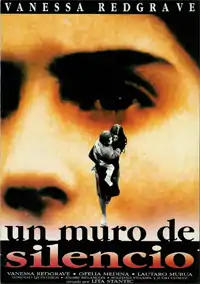| A Wall of Silence | |
|---|---|
 Promotional poster | |
| Directed by | Lita Stantic |
| Written by | Graciela Maglie Gabriela Massuh |
| Produced by | Dolly Pussi Pablo Rovito |
| Starring | |
| Cinematography | Félix Monti |
| Edited by | Juan Carlos Macías |
| Music by | Néstor Marconi |
Release date | 10 June 1993 |
Running time | 107 min |
| Countries | Argentina Mexico United Kingdom |
| Language | Spanish |
A Wall of Silence (Spanish: Un muro de silencio) is a 1993 Argentine drama film starring Vanessa Redgrave. The film concerns a turbulent period in Argentine history, the National Reorganization Process as well as the responsibility of artists in engaging and interpreting human stories from this period.[1] It was directed by Lita Stantic and released theatrically in Argentina on 10 June 1993. It was also screened later that year at the Toronto International Film Festival. It was released as Black Flowers in some English territories.
Plot
Kate (Redgrave) is a British film director on location in Argentina that traces the story of Silvia (Medina). Silvia has a dark past, stemming from the turbulent time when she endured her husband's forced disappearance during the Dirty War. Silvia wants to move on with her life and concentrate on her family. But she is eventually persuaded into reliving her painful past.[2]
Cast
- Vanessa Redgrave as Kate Benson
- Ofelia Medina as Silvia
- Lautaro Murúa as Bruno
- Lorenzo Quinteros
- Soledad Villamil as Ana-Laura
- André Melançon
- Julio Chávez as Julio-Patricio
- Graciela Araujo
Production
Stantic had the idea for the film as early as 1986 after an experience of working with the British actress, Julie Christie on Miss Mary. Christie revealed to Stantic her personal experiences of having set up her life in Argentina with the intention of discovering the recent past.[3]
It was subsequently filmed in Buenos Aires in 1992.[4] It is a co-production between Argentina's Aleph Producciones, Britain's Channel 4 and Mexico's Instituto Mexicano de Cinematografía (IMCINE).
Reception
The film was generally well-received, proving to be a success with Argentine film critics. Although this was a period when Argentine film audiences were more enthralled with viewing politics through the gaze of melodrama and rock music.[5] Redgrave was praised for her performance, especially for the striking similarities betweens her character and her real-life persona as supporter of sometimes unpopular minority causes.[6]
References
- ↑ A. Young, Richard (1997). Latin American postmodernisms.
- ↑ Un Muro de Silencio Archived February 14, 2010, at the Wayback Machine Lisa Stantic Producciones. Retrieved on 25 August 2010. Spanish
- ↑ An Interview with Lita Stantic Archived July 16, 2011, at the Wayback Machine Harvard University Press. Retrieved on 25 August 2010
- ↑ Todavía falta hacer mucho cine para entender lo que pasó Archived April 1, 2011, at the Wayback Machine Institutio Espacio para la Memoria. Retrieved on 25 August 2010. Spanish
- ↑ Bethell, Leslie (1998). A Cultural History of Latin America: Literature, Music and the Visual Arts. Cambridge University Press.
- ↑ R. Guneratne, Richard (2003). Rethinking Third Cinema. Routledge.